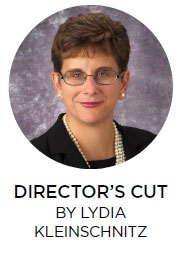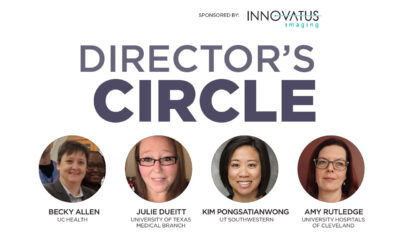
By Lydia Kleinschnitz
 Being the director of an imaging department offers lots of rewards, but also sometimes presents its fair share of challenges. When you are a senior director of multiple sites, this tends to multiply both things. I am one of those senior directors and I have oversight of two hospital-based imaging departments along with seven satellite sites; these hospitals are busy city hospitals. One is a level I Trauma Center and, combined, the hospitals have over 1,370 beds. As you can imagine, this means our imaging departments are very busy – busy with inpatients and outpatients. We offer a wide variety of imaging that one would expect to find including X-ray, CT, PET/MRI, nuclear medicine, ultrasound, MRI and interventional radiology.
Being the director of an imaging department offers lots of rewards, but also sometimes presents its fair share of challenges. When you are a senior director of multiple sites, this tends to multiply both things. I am one of those senior directors and I have oversight of two hospital-based imaging departments along with seven satellite sites; these hospitals are busy city hospitals. One is a level I Trauma Center and, combined, the hospitals have over 1,370 beds. As you can imagine, this means our imaging departments are very busy – busy with inpatients and outpatients. We offer a wide variety of imaging that one would expect to find including X-ray, CT, PET/MRI, nuclear medicine, ultrasound, MRI and interventional radiology.
The number of modalities is a factor that contributes to the number of outpatients, and their accompanying family members, who visit our department. I, along with my leadership team, had to focus on maintaining a well-run reception area. We needed one that allowed the team to process patients as quickly as possible through to their ordered imaging as well as one that allowed a comfortable place for accompanying family members. It is always reassuring to see the reception area running smoothly and seeing support family or friends waiting in comfort. One thing you don’t want to see are people standing around with nowhere to sit and wait.
At least that was the case before COVID-19 hit. With the pandemic, came the need to maintain social distancing to help limit any transmission of the virus. In the beginning, we limited outpatient care in order to conserve resources for those that were struck with the illness. As time went on, we found that in our region of western Pennsylvania we did not see that initial huge influx of COVID patients. Suddenly, we were trying to catch up with all those outpatients that we had placed on hold in order to deal with the pandemic. Our outpatient reception areas were at capacity – even with limits on how many people a patient could bring with them. Nothing seemed to ease the congestion we were experiencing.
As a leadership team, we had to figure out a way to keep the six-feet gap between those that were waiting. Initially, we tried to turn chairs around or used chair hanging cards that designated chairs that should not be used. Low and behold, family members would turn the chairs around or sit on the cards. We ended up with squashed chair cards, disorganized chair rows that were trip hazards and complaints that we were not really working to keep our patients safe by allowing unrelated people to sit so close together. It seemed to be an impossible task. How could we continue to offer critical outpatient services, allow those that accompanied patients to be comfortable and maintain safe distancing all in a limited space?
A critical decision had to be made, one that as a senior director I never thought I would have to make. I had to enforce a limit on the number of people in our reception area and we needed to remove chairs from our reception areas. What a foreign concept, I was usually trying to find more chairs. Now, I was asking facilities to move chairs to unoccupied offices or unoccupied non-patient areas!
Our team continues to make efforts to reach out to patients prior to arrival to remind them to bring only one support person. Our reception team offers other areas for family members to sit. Our techs and nurses attempt to minimize turnaround times. Patients and family are now able to successfully maintain social distancing. Complaints and fears have been decreased and we continue to provide services for our outpatients. I am hopeful that as vaccines are distributed, that soon, I will be able to reverse the chair count. I will be able to replace those chairs and provide a comfortable safe place for all to wait. I sure hope I can remember where I put those chairs.
Lydia Kleinschnitz, MHA, BSN, RN, is the senior director of imaging services at UPMC Presbyterian Shadyside.








